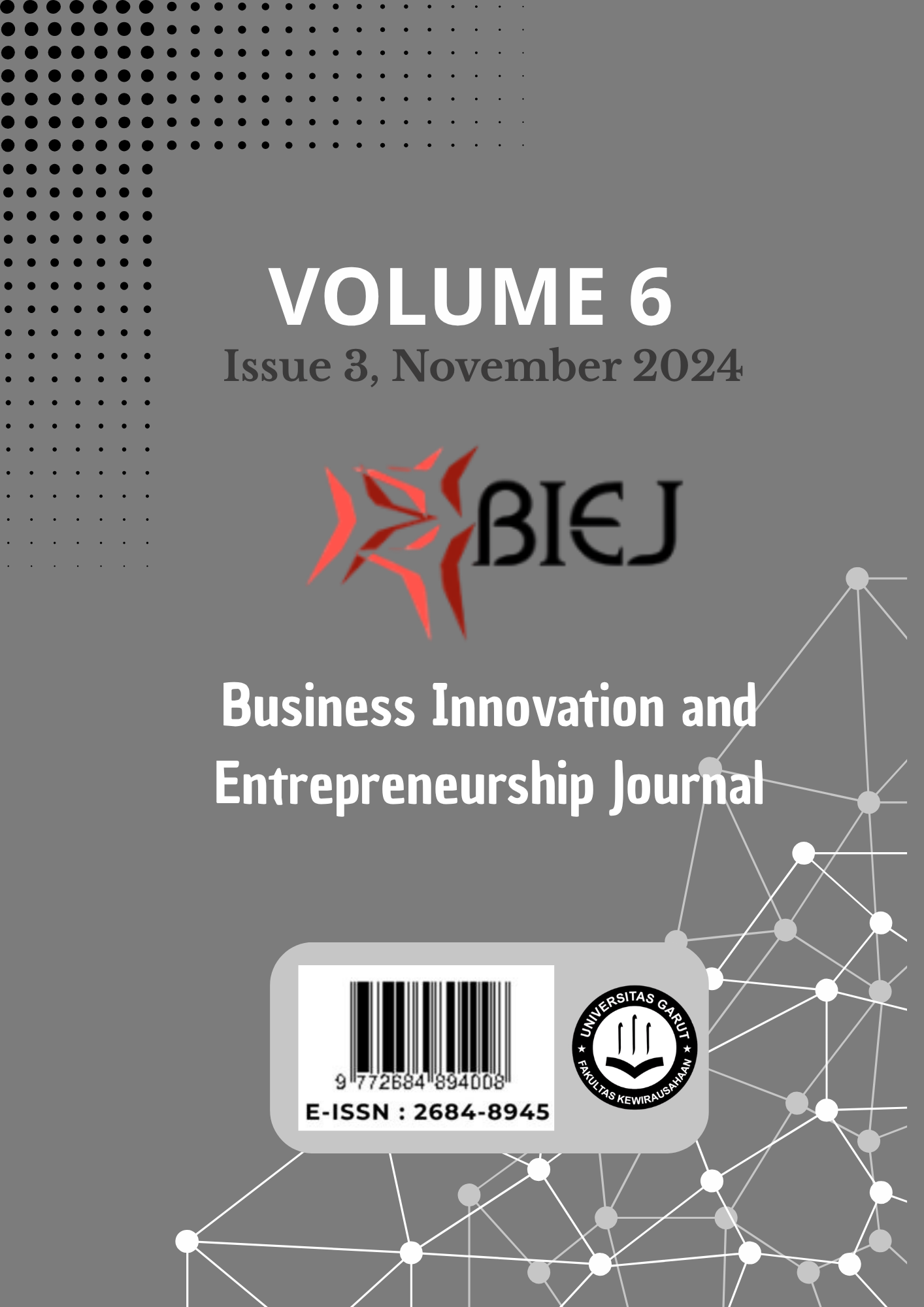Analysis Planning “Viera” Business Silk Natural" Using Business Canvas Model
Abstract
This research aiming to describe and analyze a Business Model with the Business Model Canvas Approach on Viera Sutra Alam which consists of 9 elements, there are: (1) Customer Segments, (2) Value Propositions, (3) Channels, (4) Customer Relationships, (5) Revenue Streams, (6) Key Resources, (7) Key Activities, (8) Key Partnership And (9) Cost Structures. This research approaches uses a qualitative with case study method. Data collection was carried out using interviews, observation and questionnaire techniques. The results of the analysis show that the Viera Silk Natural Canvas Business Model has changed after involving the customer's perspective through a questionnaire distributed on google form. The parts of Business Model Canvas that have changed are: Customer Segments, Value Propositions, Customer Relationships, Channels And Key Partners.
Downloads
References
Z. Wei, “Navigating digital learning landscapes: unveiling the interplay between learning behaviors, digital literacy, and educational outcomes,” Journal of the Knowledge Economy. Springer, 2024, doi: 10.1007/s13132-023-01522-3.
M. Betaubun and A. M. Anggawirya, “Global Pandemic and Its Effect on Papuan EFL Students’ Digital Concepts,” J. Kependidikan J. Has. Penelit. Dan Kaji. Kepustakaan Di Bid. Pendidik. Pengajaran Dan Pembelajaran, vol. 8, no. 3, p. 579, 2022, doi: 10.33394/jk.v8i3.5529.
E. N. Qorimah and W. C. Laksono, “Keterlibatan Guru Dalam Proses Perkembangan Kemandirian Peserta Didik Sekolah Dasar,” J. Basicedu, vol. 7, no. 3, pp. 1391–1397, 2023, doi: 10.31004/basicedu.v7i3.5180.
E. K. Aini, “Entrepreneurship Intention: the Effect of Fear and Anxiety of Covid-19 and Opportunity Recognition,” Profit J. Adm. Bisnis, 2022.
A. Joyce, “The triple layered business model canvas: a tool to design more sustainable business models,” J. Clean. Prod., vol. 135, pp. 1474–1486, 2016, [Online]. Available: https://doi.org/10.1016/j.jclepro.2016.06.067.
M. F. Fawaz, G. Abdul, F. Maulani, and N. A. Hamdani, “Optimizing the Search for Grass Supply for Domba Garut Farmers Through Location-Based Mobile Application,” vol. 5, no. 4, pp. 291–299, 2023.
S. A. Qalati, D. Ostic, M. A. B. A. Sulaiman, A. A. Gopang, and A. Khan, “Social media and SMEs’ performance in developing countries: Effects of technological-organizational-environmental factors on the adoption of social media,” SAGE Open, vol. 12, no. 2, p. 21582440221094590, 2022.
M. Setyaningtyas, “Strategi pengembangan tanaman pangan guna meningkatkan perekonomian Kabupaten Kebumen,” Econ. Dev. Anal. J., vol. 5, no. 2, pp. 170–178, 2018, [Online]. Available: https://doi.org/10.15294/edaj.v5i2.22030.
N. Khofifah and D. Moentamaria, “Penjadwalan dan pengembangan rencana kerja di industri yoghurt.”
A. Putri and F. Nurnisya, “Imokey’s integrated marketing communication strategy in increasing product sales in 2022,” in Symposium of Literature Culture and Communication (Sylection) 2022, 2023, vol. 3, no. 1, p. 286, doi: 10.12928/sylection.v3i1.13995.
N. A. Hamdani, R. Muladi, G. Abdul, and F. Maulani, “Digital Marketing Impact on Consumer Decision-Making Process,” vol. 220, no. Gcbme 2021, pp. 153–158, 2022.
R. Khairunisa, I. Marie, P. Moengin, N. Widayanti, and N. Nilla, “Peramalan permintaan menggunakan jaringan syaraf tiruan dan perencanaan produksi menggunakan linear programming pada perusahaan aluminium,” J. Tek. Ind., vol. 11, no. 3, pp. 196–203, 2021, doi: 10.25105/jti.v11i3.13060.
M. Mustaruddin, A. Asnil, and A. Nugraha, “Sistem informasi perikanan tangkap D.I. Yogyakarta: pengembangan basis data lingkungan, produksi, dan sistem keputusan penangkapan ikan,” Albacore J. Penelit. Perikan. Laut, vol. 4, no. 1, pp. 97–107, 2021, [Online]. Available: https://doi.org/10.29244/core.4.1.097-107.
F. Izzatunnisaa and E. Prasetyaningsih, “Perencanaan produksi dan persediaan untuk mengurangi keterlambatan dan biaya penalti,” J. Ris. Tek. Ind., pp. 117–128, 2022, doi: 10.29313/jrti.v2i2.1250.
D. Kusumawati, “UPAYA GURU DALAM MENGEMBANGKAN KECERDASAN INTERPERSONAL PADASISWA KELAS V MI GUPPI LABAN SUKOHARJO TAHUN AJARAN 2019/2020,” Surakarta, 2020.
F. Hermawan, Y. Sastrawijaya, and E. Kamaruddin, “Pengaruh pembelajaran jarak jauh terhadap hasil belajar mahasiswa universitas negeri jakarta,” Pinter J. Pendidik. Tek. Inform. Dan Komput., vol. 6, no. 2, pp. 54–60, 2022, doi: 10.21009/pinter.6.2.7.
J. W. Creswell, Research Design Pendekatan Kualitataif, Kuantitatif, dan Mixed. Yogyakarta: pustaka pelajar, 2016.
Sugiyono, metode penelitian kualitatif kuantitatif dan R&D, 2nd ed. Bandung: ALFABETA cv, 2019.
M. Alfarizi et al., “Anteseden niat kewirausahaan berkelanjutan gen z kawasan smart city semarang: apakah teknologi dan pemerintah daerah berperan?,” J. Riptek, vol. 17, no. 2, pp. 159–176, 2023.
K. Nastasia and I. Khairiah, “Hubungan Antara Religiusitas dengan Perilaku Prososial pada Remaja di SMA Negeri 1 Lembah Gumanti Kabupaten Solok,” Psyche 165 J., vol. 14, no. 4, pp. 359–365, 2021, doi: 10.35134/jpsy165.v14i4.131.



























